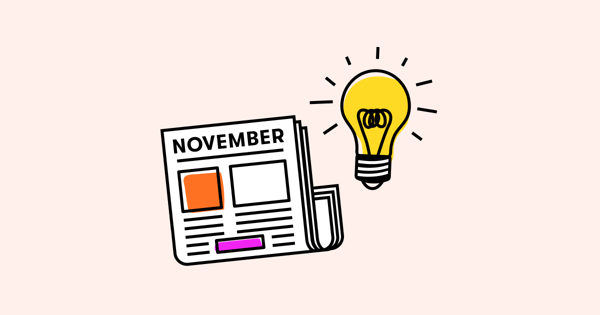Ever wish ecommerce marketing was less boom-and-bust?
You spend the long summer months scratching around for marketing ideas, while a dispassionate audience studiously ignores you.
Then November comes around and it’s full-on migraine season. You’ve got a billion campaigns to plan and launch before Black Friday. Not only that, but everyone’s suddenly desperate to hear from you: November has the highest average email open rate of any month.
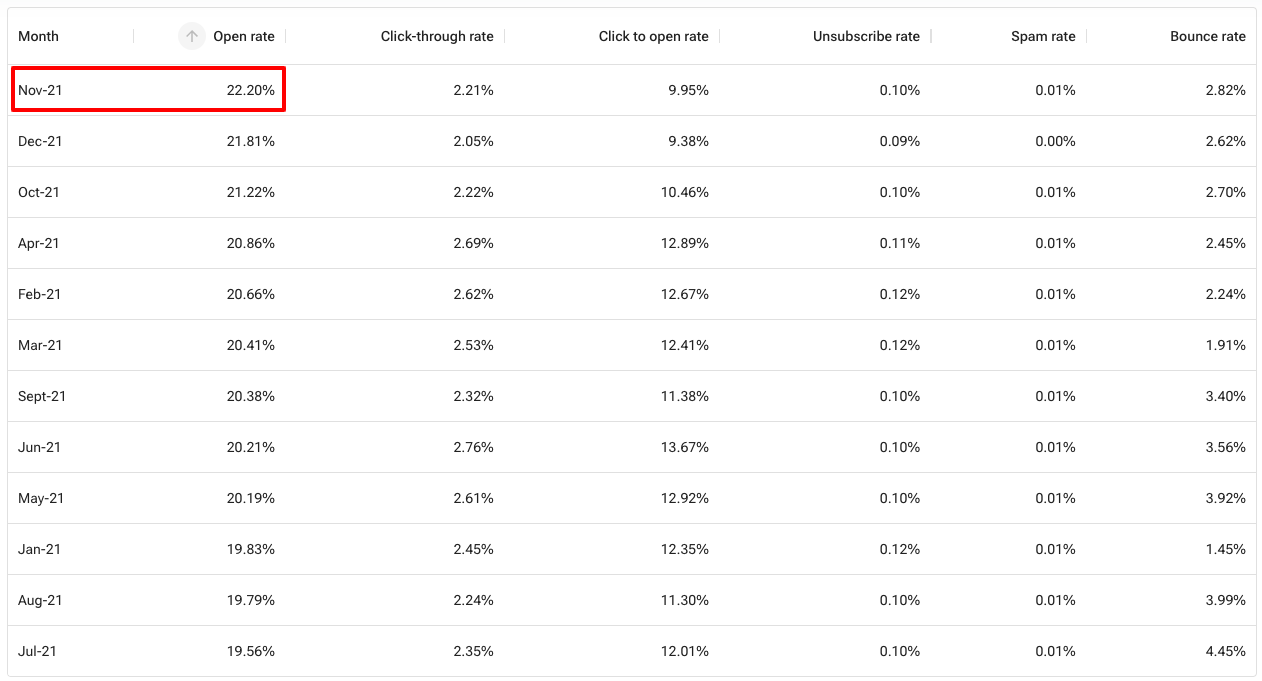 While consumer trends inevitably change over time, there are no signs whatsoever that we’re getting tired of spending, spending, and spending some more in the run-up to the ecommerce holiday season.
While consumer trends inevitably change over time, there are no signs whatsoever that we’re getting tired of spending, spending, and spending some more in the run-up to the ecommerce holiday season.
Quite the opposite. The National Retail Federation (NRF) predicts bumper retail sales in 2022, with holiday spending expected to reach between $942.6 billion and $960.4 billion. That’s a six percent to eight percent uptick on the record sales generated in 2021.
Online and other non-store sales are expected to grow even faster, with the NRF forecasting a year-on-year increase of up to 12 percent.
All of which means you’re probably not reading this article because you’re short on November newsletter ideas. More likely, you’ve got more potential campaigns than you can shake an SKU at.
But spray-and-pray email marketing just won’t cut it in November. If your messaging doesn’t hit the mark, you risk derailing the whole holiday season.
That’s why I’ve raided the Drip email swipe file to round up seven engaging, persuasive, high-converting November newsletter ideas…

7 November Newsletter Ideas
- The Frye Company: Use Email to Build Your SMS List
- Everlane: “One For You, One For Me”
- L’Occitane: Encourage Shoppers to Segment Themselves
- KitchenAid: Start Black Friday Early
- The North Face: Add a Countdown Timer to BFCM Emails
- Bombas: Boost Open Rates With Creative Subject Lines
- KiwiCo: Ease Gift-Giving Anxiety
1. The Frye Company: Use Email to Build Your SMS List
Here at Drip, we’re obviously big fans of email marketing. But that doesn’t mean email should be the only channel you use to reach customers. During such a critical time of year for sales, it makes sense to take a multichannel approach.
One strategy is to add SMS messaging to your marketing mix. The majority (58 percent) of consumers agree that between texts, emails, and phone calls, texts are the best way for marketers to reach them in a hurry.
Things move quickly in November. When new products and offers are dropping daily, it makes sense to leverage a communications channel guaranteed to grab your audience’s attention fast.
I know what you’re thinking: “What does any of this have to do with email newsletters?”
Relax, I’ll tell you.
Consent is important in any form of marketing. But reaching a customer on their iPhone feels more intimate than hitting their email inbox. For that reason, consumers generally don’t want to receive texts from brands unless they’ve opted-in first.
That’s where email comes in.
Last November, US footwear manufacturer The Frye Company shared an email solely aimed at convincing its marketing list to opt-in for SMS messages from the brand:
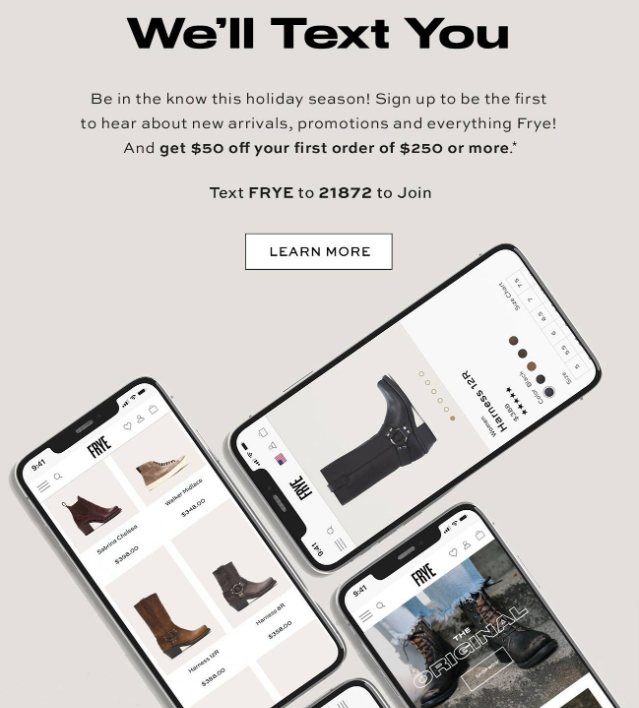 I like the positioning here. Frye explains that opting in will ensure customers are the first to know about new products and promotions. It’s all about making people’s lives easier at a busy time of year, rather than bombarding them with yet more marketing communications.
I like the positioning here. Frye explains that opting in will ensure customers are the first to know about new products and promotions. It’s all about making people’s lives easier at a busy time of year, rather than bombarding them with yet more marketing communications.
To sweeten the pot, it also chucks in a $50 discount.
(N.B. Like the sound of SMS? Learn how to automate your marketing with best practice email and SMS workflows from Drip.)
2. Everlane: “One For You, One For Me”
Theoretically, holiday shopping is about buying stuff for your nearest and dearest.
But we’re only human. We see a shiny thing and we can’t help coveting it, even if our original intent was to buy it for our partner or sibling.
Don’t worry: if you’re “guilty” of this, you’re not the only one. In fact, research from JLL found that 53 percent of consumers plan to buy for themselves while holiday shopping, climbing to 73.5 percent of shoppers with gifting budgets of more than $500.
Clothing and shoes are comfortably the most popular “self-gifts”, with 20.4 percent of shoppers planning to buy products for themselves within this category. Electronics (11.5 percent) and home furnishings (8.3 percent) came in second and third respectively.
Theoretically, this is all fantastic news for retailers. What could be better than a customer landing on your site, buying a gift for a loved one, then deciding to snap one up for themselves as well? You’ve doubled your cart value in the blink of an eye.
But consumer psychology is a fascinating beast. Even though we’re happy to admit to treating ourselves in the holiday season, we’re also wracked with guilt and remorse about how much we spend. This is particularly true among Millennials, 26 percent of whom said they feel bad about spending too much on gifts.
This puts marketers in something of a pickle. On one hand, you want to encourage shoppers to treat themselves. But on the flip side, you don’t want to over-egg the (Christmas) pudding with too much self-gift messaging for fear of scaring away guilt-ridden customers.
Everlane strikes the perfect balance in this November newsletter example:
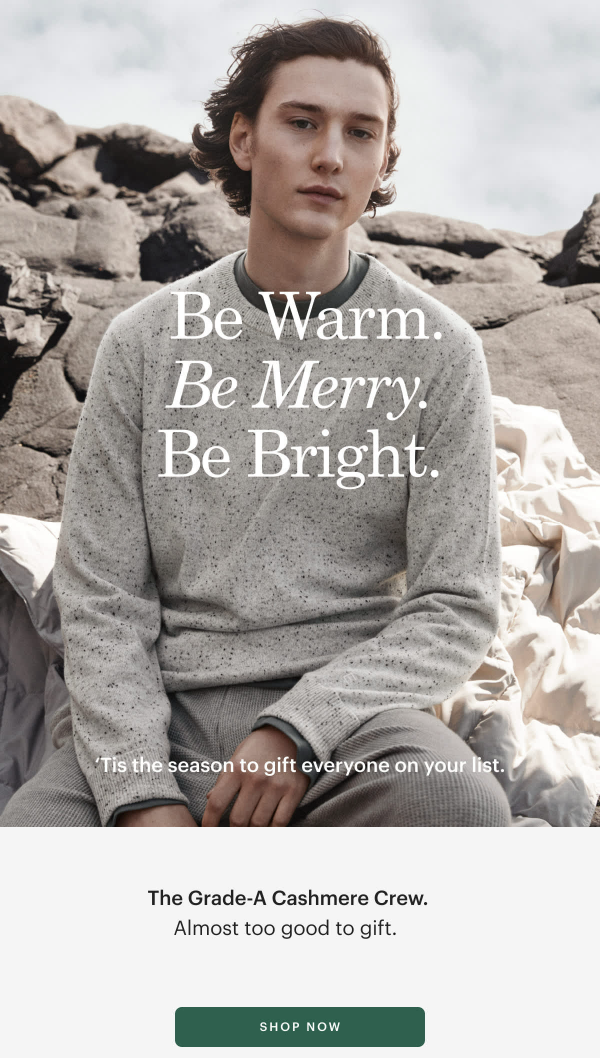 The implication is subtle but effective: if it’s almost too good to gift, maybe I should buy one for myself?
The implication is subtle but effective: if it’s almost too good to gift, maybe I should buy one for myself?
3. L’Occitane: Encourage Shoppers to Segment Themselves
I probably don’t have to convince you about the benefits of segmentation.
From an email marketing perspective, Mailchimp found that segmented campaigns achieve:
- Four percent higher open rates
- 11 percent more unique opens
- 101 percent more clicks
The same is true across all channels.
Why? Because the more you segment, the more you can personalize. And the more you personalize, the more you can sell, with 90 percent of leading marketers agreeing that personalization significantly contributes to business profitability.
You probably expect my next November newsletter idea to be all about email marketing segmentation. But instead, we’re going to look at how segmenting customers within your emails can boost conversion rates when they arrive on your website.
In this email, French luxury retailer L’Occitane en Provence encourages readers to click on the gifting category that best suits their budget:
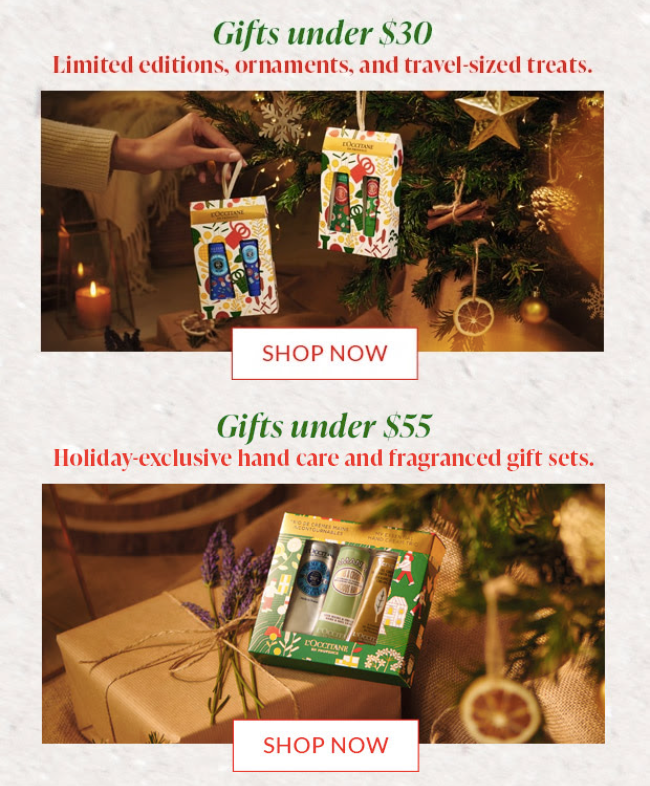 As with so many of the best ideas, it’s also devilishly simple.
As with so many of the best ideas, it’s also devilishly simple.
By effectively persuading customers to segment themselves, L’Occitane ensures it will present them with the most relevant landing page. That way, there’s a much higher chance they’ll actually buy something.
(N.B. Want to learn more? Find out how Drip’s segmentation and personalization tools help marketers craft hyper-personalized messaging that converts.)
4. KitchenAid: Start Black Friday Early
Americans are poised to shell out a stunning $158 billion on Black Friday 2022, with 76 percent of consumers planning to shop for deals, according to research from Future Publishing.
In other words, Black Friday is kind of a big deal.
Obviously, I could have dedicated this entire article to Black Friday, but we’ve done that plenty of times before. (However, I’d definitely recommend checking out our roundup of little-known Black Friday marketing strategies when you get a chance.)
Instead, I’m going to share just two Black Friday email ideas that you should definitely consider for your November marketing.
First up, KitchenAid cuts through all the noise by launching its Black Friday offer on November 9th, a full two-and-a-half weeks before the day itself:
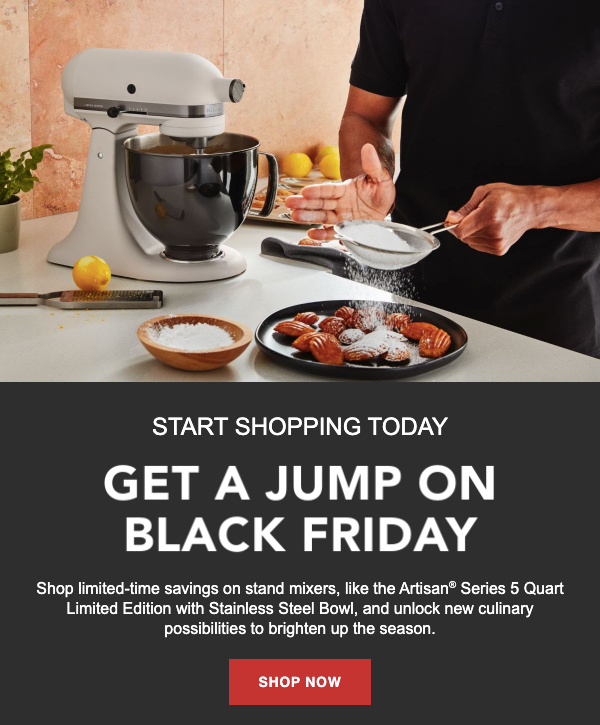 This is a smart tactic. With more emails sent on Black Friday than any other day of the year, the chances of cutting through the noise are comparatively slim. So why not beat the rush?
This is a smart tactic. With more emails sent on Black Friday than any other day of the year, the chances of cutting through the noise are comparatively slim. So why not beat the rush?
Launching your Black Friday proposition early also offers practical, logistical benefits.
If your efforts are geared toward driving a disproportionately high volume of sales on a single day, you’re practically guaranteed to push your website, warehouse teams, and shipping providers to their limits.
There’s always the risk that something—or several things—will snap. And this problem doesn’t just apply to smaller brands; even huge corporations like Best Buy have been hit by website outages on Black Friday.
So it pays to spread the workload—plus it helps you get a jump on the competition.
5. The North Face: Add a Countdown Timer to BFCM Emails
Want one more Black Friday email idea? You’ve come to the right place, although this one also applies to Cyber Monday (and to any other limited-time offer, for that matter).
This time, I’m going to start with the email and work backward:
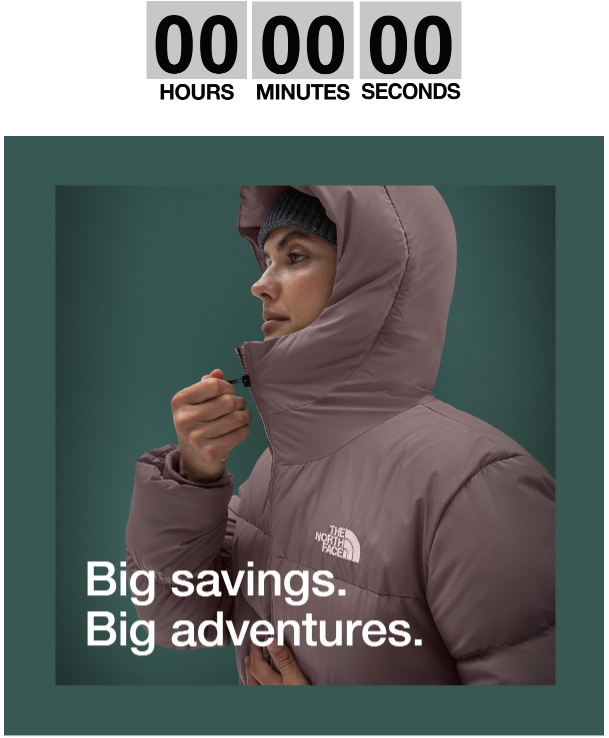 What’s so great about this relatively simple newsletter? The countdown timer.
What’s so great about this relatively simple newsletter? The countdown timer.
(Ignore the fact it’s already counted down to zero.)
In our experience, countdown timers are comparatively underused, yet they’re extremely effective when used well. And we’ve got the data to prove it.
We previously reviewed our data across more than 20 million website popup views. Our research discovered that when popups include a countdown timer, they convert at a staggering 112.93 percent higher rate than those without a timer.
You can obviously use this tactic with any of your BFCM messaging, but it works best for sending reminders that your sale is coming to an end. That way, you’re not just telling people that they’re running out of time to grab a bargain—you’re showing them.
6. Bombas: Boost Open Rates With Creative Subject Lines
Cast your mind back to the introduction of this article and you’ll remember that November sees higher email open rates than any other month, at 22.2 percent.
Great news for email marketers, right?
But it’s never quite as simple as that. One study found that emails with subject lines containing the phrase “Black Friday” only see open rates of 14.9 percent, while those with “Cyber Monday” fared even worse, with average open rates of 13.8 percent.
So consumers open marketing emails at a higher rate in November, but they don’t seem to love overtly Black Friday or Cyber Monday-themed messaging. What’s going on?
My take is that consumers get bored reading the same subject lines over and over again. If you have 25 unopened emails, all with “Black Friday” in the subject, there’s no differentiation. Unless you happen to love one of those brands, or were already planning to buy from them, there’s nothing to compel you to open any of them.
That’s why I recommend getting a little creative with your subject lines, especially as BFCM approaches.
Speaking of creativity, one of my favorite strategies is to spark curiosity in your audience, like Bombas did in this subject line:
![]() If you like Bombas enough to have signed up for their marketing list, there’s a good chance you’ll want to know what that “item” is. It’s a far more impactful subject line than: “Buy these socks.”
If you like Bombas enough to have signed up for their marketing list, there’s a good chance you’ll want to know what that “item” is. It’s a far more impactful subject line than: “Buy these socks.”
7. KiwiCo: Ease Gift-Giving Anxiety
Turns out a lot of us live in fear of holiday shopping.
One study found that 25 percent of consumers worry about purchasing clothes in the wrong size, while 18 percent stress about their gifts arriving on time. Other common concerns include:
- Worrying about choosing the wrong color
- Worrying about the price tag showing
- Worrying about not having the recipient's mailing address
With all that anxiety floating around, it’s a wonder any of us ever manage to get in the festive spirit.
As marketers, we can make life a whole lot easier—and less stressful—for customers by providing trust signals that reassure them about their planned purchases.
KiwiCo gets it right in this November newsletter:
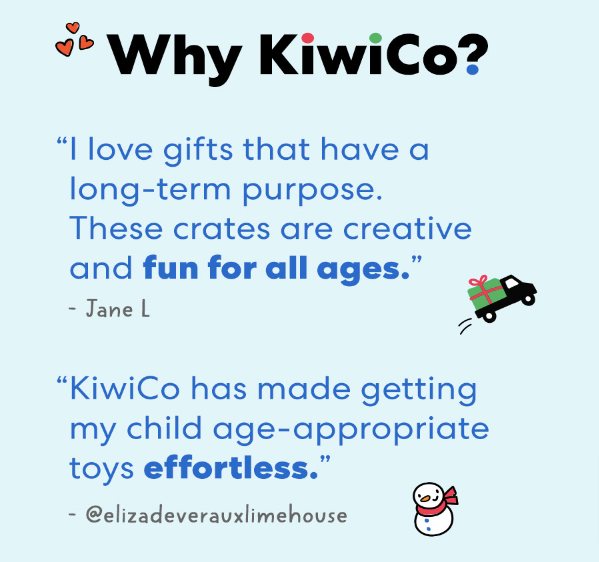 The messaging strikes exactly the right chord, convincing shoppers with real-life customer testimonials that speak to the myriad virtues of KiwiCo’s child-friendly subscription boxes.
The messaging strikes exactly the right chord, convincing shoppers with real-life customer testimonials that speak to the myriad virtues of KiwiCo’s child-friendly subscription boxes.
I particularly like how they included one of the social handles, which makes it clear that the review wasn’t just invented on the fly by their copywriter.

Make Smarter Marketing Decisions With Drip
Ever feel like you’re flying blind when it comes to email marketing?
Like you’re swamped by data, but none of it really tells you anything?
Lots of other marketers feel the same. That’s why we built the Drip platform to offer nothing but actionable insights and guidance for boosting engagement, conversions, and revenue.
Of course, I don’t expect you to take my word for it. Instead, I’d prefer you to find out for yourself by signing up for your 14-day free trial.

